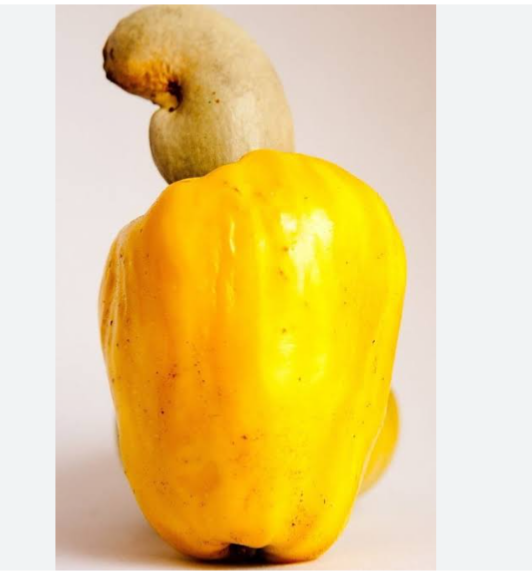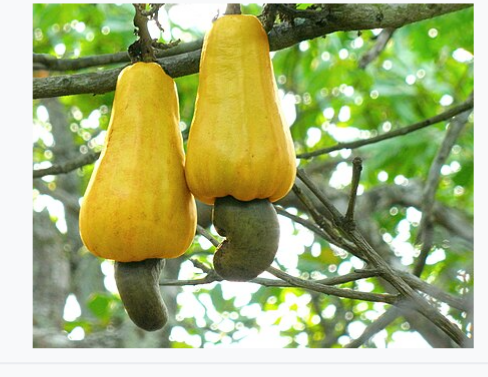
Plantation crops are tree crops grown either For local consumption or commercial purposes. They are source of foreign exchange earning for a nation and income to farmers. Some of the plantation crops include cocoa (Theobroma cacao) , rubber ( Hevea brasiliensis) , cashew ( Anacardium occidentale), cola (Cola nitida or Cola acuminata), citrus (Citrus spp) , mango (Mangifera indica) , oil palm (Elaeis guineensis), coffee ( Coffea spp), cotton (Gossypium spp) and plantain ( Musa paradisianca) etc. They are all first raised in the nursery after which they are transplanted, usually on large hectrage of land.
Commodity cashew belong to thesame family Anacardiaceae with mango. It produces an apple which is a modified food. The apple is made up of a fleshy stalk and fruit or seed. Inside the fruit is the nut. The cashew nut is edible and is eaten on its own as a snack, used in recipes, or processed into cashew cheese or cashew butter. The nut is often simply called a ‘cashew’. It can thrive better under suboptimal rainfall of about 900mm/annum
ORIGIN: Cashew originates from Central and southern America. Now, it is grown enmass in almost all part of the world including Nigeria.
CASHEW FRUIT: Fruit of cashew are called pseudo apple. That is, false fruit which is rich in vitamins and the nut is proteineous. The cashew apple is light reddish to yellow in colour. The fruit is oval or pear-shaped called a hypocarpium. It develops from the pedicel and the receptacle of the cashew flower.
The true fruit is a kidney-shaped drupe that grows at the end of the cashew apple. The drupe first develops on the tree and then the pedicel expands to become the cashew apple. The drupe becomes the true fruit. The fruit is double shell-encasing the seed called a nut. The double shell contains an allergenic phenolic resin, anacardic acid (a potent skin irritant) and also toxic allergenic oil urushiol.
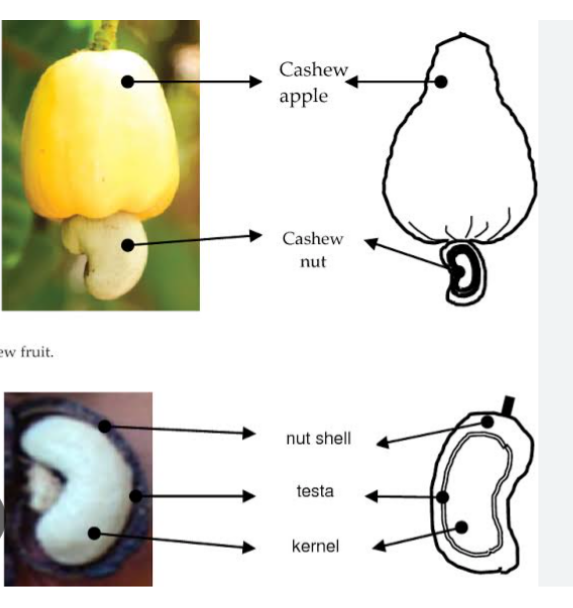
TYPES OF SEED: There are different varieties of cashew. But in country like Nigeria, there are two major types of cashew seeds. The local seed and the Brazilian seed. The Brazilian seed is more preferred in the international market.
MAJOR PRODUCERS IN AFRICA: Kenya, Mozambique, Tanzania, Zambia and Nigeria. In Nigeria, it strive better at latitude along ilorine and benue state.
USES OF CASHEW
1. The false fruit contain juice that can be processed industrially.
2. The residue or after the juice can be dried and converted to fodder or fermented to get ethanol.
3. The nut (real fruit) can be salted and roasted and eaten as snack. The nuts are always in high demand globally.
4. The shell of the nut contain oil which can be used in the manufacture of plastics and paints
5. The shell of the cashew nut contains oil compounds that can cause contact dermatitis similar to poison ivy, primarily resulting from the phenolic lipids, anacardic acid, and cardanol
6. Cashews are rich sources of dietary minerals such as copper, manganese, phosphorus, and magnesium. Also, it contain Iron, potassium, zinc, and selenium in significant content.They also contain thiamin, vitamin B6 and vitamin K
7. Cashews are commonly used in South Asian China and Philippines etc for garnishing sweets or curries, or ground into a paste
8. Some countries manufacture cashew milk which is a plant milk alternative to dairy milk.
9. Cashew nut husk is used in industrial applications, such as an adsorbent, composites, biopolymers, dyes and enzyme synthesis
10. The mature cashew apple can be eaten fresh, cooked in curries, or fermented into vinegar, citric acid or an alcoholic drink.
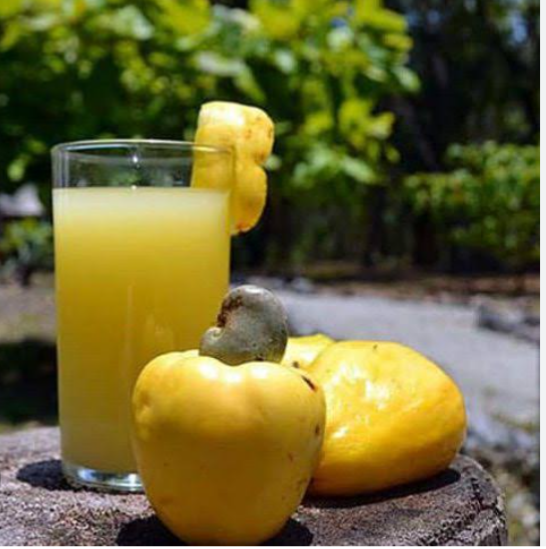
11. Cashew apple is also used to make preservatives, chutneys and jams.
12. Cashew nut oil is used for cooking or as a salad dressing. It is the highest quality oil to be produced
13. Cashew nutshell liquid (CNSL) or cashew shell oil is used in tropical folk medicine and for anti-termite treatment of timber.
14. Anacardic acid is also used in the chemical industry for the production of cardanol, which is used for resins, coatings, and frictional materials.
15. Discarded cashew nuts unfit for human consumption, alongside the residues of oil extraction from cashew kernels, can be fed to livestock. Animals can also eat the leaves of cashew trees.
ADVANTAGES OF CASHEW PRODUCTION
1. It can grow on degraded soil especially where the soil is too poor for citrus and other plantation crops
2. Cashew is drought tolerant
3. It is a low maintenance tree crop
4. It can be interplanted with arable crops like maize, soybeans, cowpea and groundnut else etc. In Kenya, it is interplanted with tree crops like coconut and mango.
Interplanting cashew with other has advantages of weed control, and source of additional income to farmers. Interplanting with legumineous arable crops fix atmospheric nitrogen to the soil.
PROPAGATION METHOD: Cashew seeds should be planted together to have a uniform germination. The seed should be planted in such a way that the scar faces upwards. The seeds should be raised in the nursery in polythene bags. In about 3 months after germination, the seedlings should be transplanted on the field. Leaving beyond 3 months in nursery polythene bags might result in the plant developing roots that penetrate deep into the soil out of the polythene bag. This therefore will result in cutting the root of the seedling. Cashew is drought tolerant and can survive where other plants cannot survive.
Cashew seeds can also be sown at stake, that is, it may be sown directly into the field in some cases, which is called “planting in-situ”.
Other propagation methods of cashew include Air-layering was, Epicotyl grafting and Soft-wood grafting
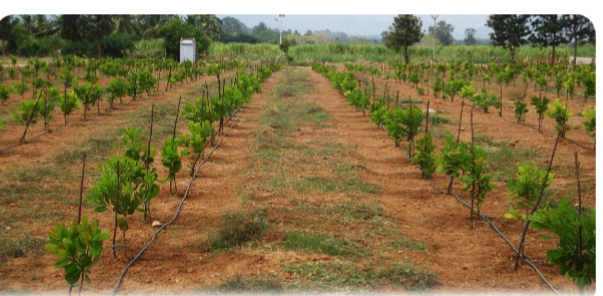
ESTABLISHMENT: The land should be properly cleared of all vegetation before ploughing. At times the land is not totally cleared especially for crops that require shade. The shade protect the crops. The land is stumped immediately after ploughing, then harrowed. The land should then be blocked. This is done by linning and pegging which is very important for plantation crops. Without which plantation planting operation becomes a wrong planting operation. The seedlings should then be planted at planting cordinate of 9m by 9m or 10m by 10m or 12m by 12m spacing at 25cm soil depht. Note that cashew seeds looses viability faster compared to other crop seeds.
STEPS INVOLVE IN LINING AND PEGGING OPERATION
1. Reconnaissance survey: This is carried out to have a general overview of the site. Then a diagram is provided to show a rough sketch of the farm area. Line is then drawn to show the baseline and perpendicular lines using the 3 – 4-5 method. If this is done properly, a right planting operation is achieved. This is then replicated on the farm land.
2. PEGGING: This is then done using a ranging pole. Then the planting space is measured. Pegging is important in making an aesthetic area of land while spacing is important for the following reasons:
a. For good management
b. When there is good lining out, pegging and spacing will allow mechanisation practices.
SOIL AND CLIMATIC REQUIREMENT : Sandyloam or sandy soil which are slightly acidic (pH 4.5 to 5.0) is required. It requires rainfall of 900mm to 3000mm per annum.
PLANTING: When seedlings are transported for transplanting on field, seedlings are layedout, which is the placement of the seedlings beside the pegs before planting at the recommended spacing above.
After planting, dead seedlings should be supplied.
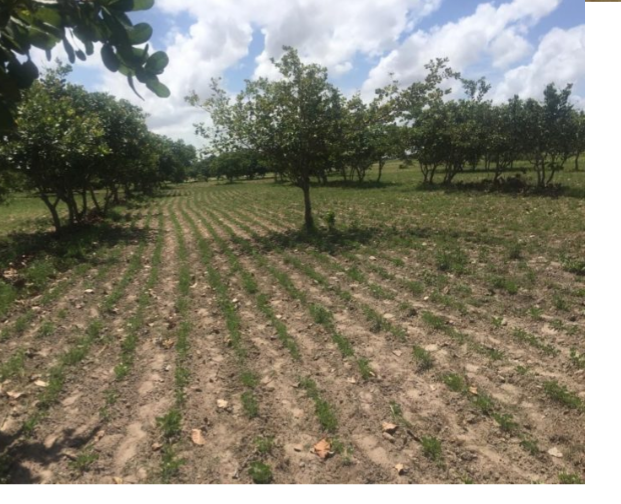
WEED CONTROL: Cashew plantation should be weeded twice before fruiting. First weeding should be ring weeding. This is the weeding of the base of the cashew tree or seedling at about 2m away from the stock of the plant.
Secondly is the row weeding, which is weeding along the row.
Other weeding alternatives include:
1. Intercropping for the first two years of transplanting is a good weed control measure. Intercropping with crops like mucuna, cover crops, cowpea, soybeans, green gram, Leucaena, and maize. But proper care must be enbacked upon.
2. When the cashew is about 2 to 3 years old, ruminants can be allowed to graze around the field
3. For large estate establishment, tractor mounted slasher can be employed to control the weeds. The slashing blade should be prevented from the base stock of the tree or seedlings as not to cut them off.
4. Spraying of herbicides like Agrodar-96 (2-4 D) can be used
5. Mulching around the base of trees helps in the control of weeds, retention of moisture and modulation of soil temperature.
Weeds do not offer serious competition with the trees but can constitute a major fire hazard especially in drier tropics ( fire trazzing). Therefore, the weeds should be controlled
OTHER MANAGEMENT PRACTICES
1. Farmyard manure should be placed in planting holes before transplanting the seedlings. Half kg should be applied per hole. This will hasten root development
2. For inorganic fertilizers,
40kg/hec of sulfate of ammonia
62.5kg/hec of murate of potash. And
12.5 kg/he of single super phosphate
All mixed together and applied as basal application should be done. Basal fertilizer application is best for cashew.
3. 3 months after planting, all side branches should be pruned until a clean boll of about 1 to 12m is achieved.
4. Mulching can be done to conserve moisture in the soil especially during dry seasons in the tropics.
5. Training and Pruning: During the initial phase of cashew establishment, shoots arising on the root stock of grafted plants have to be regularly removed to promote better scion growth, particularly in the first year after planting. Scion rejection may occur if rootstock shoots are left unchecked. Training of young trees during the first three years is essential to develop uniform canopies. Training in the juvenile phase comprises of removing basal branches and water shoots. The plants are trained to a single stem and branches are allowed to grow to about 0.75-1m from ground level. Deformed branches should be removed during the first few years. Since cashew trees tend to spread their canopies and lodge easily, proper staking is also essential. Trees are kept under check by topping off the main stem at a height of 4-5m from ground level.
Pruning has to be carried out atleast once in three years when unwanted growth is removed to provide adequate sunlight into the canopy. Since fruiting is only encouraged from the third year, de-blossoming has to be carried out as flower clusters appear during the juvenile phase
6. Use of cover crops. Popular cover crops for cashew plantations are Peuraria javanica, Calapagonium muconoides and Centrosema pubescens which improve the fertility and moisture balance and help conserve the soils.
PEST AND DISEASES OF CASHEW
PEST: The major pests are the tea mosquito bug ( Helopeltis antonii), stem/root borer (Plocaecderus ferrugineus L.) , leaf minor, leaf and blossom webber and flower thrips
DISEASES :
1. Anthracnose is the common damaging disease of cashew
2. die-back caused by a secondary infection of Botrydiplodia theobromae.
HARVESTING AND PROCESSING: Cashew will start fruiting at 3 years after planting and get to it’s peak of production at 8 years. And continue fruiting for 30 years. After which, degradation sets in.
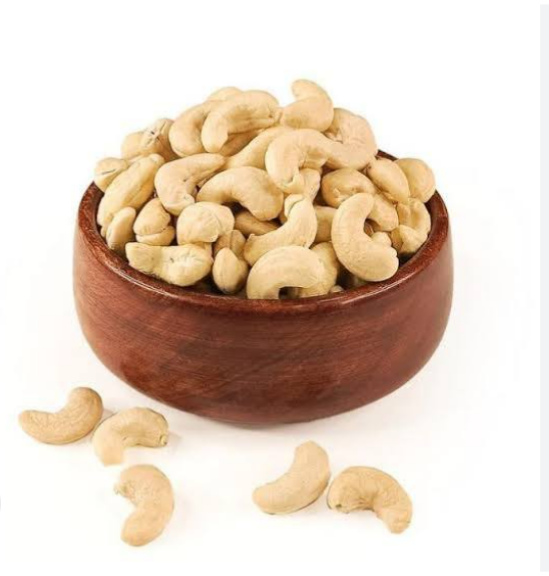
In the tropic, fruiting starts between January and April and attain it’s peak in February to march. All the trees develop both male and bisexual flowers.
Harvesting can be done by farmers cutting of the ripe fruits from the mother plant or they wait for the fruits to fall to the ground which is the right procedure. When the fruits fall to the ground, it means they are ripe and should be picked and transported to the factory for processing.
CAUSION: When planting, It is good to link up with the market to meet the middle men’s demand than the factory.
